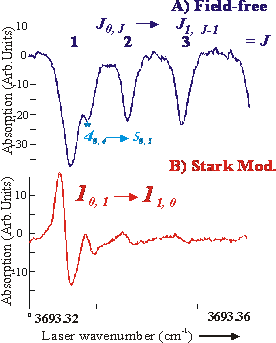

47059-AC6
Probing the Metal Activation of C-H Bonds Using High-resolution Mid-infrared Laser Spectroscopy
Although molecules and alloys containing late 4d and 5d series metals Rh, Pd, Ir and Pt are the most active catalytic agents, the cost and difficulty in their preparation has hampered their widespread use. Discovering the molecular level mechanism for their unusual catalytic activity, through a coordinated theoretical and experimental investigation of simple Rh, Pd, Ir and Pt chemical reactions, is an effective route for developing alternative catalytic agents. Here the experimental detection and characterization of proposed gas-phase insertion products formed by the oxidative addition reaction (Eq.1) of naked transition metal atoms with methanol, methane, and halogenated methane has been initiated.
 (1)
(1)
Theory predicts that the reaction proceeds along a path in which the reagent (R) forms a weakly-bound reactive complex (RC), followed by the passage through a transition state (TS) that resembles a h2-complex and finally leads to the formation of an insertion product (P):
 . (2)
. (2)
R RC TS P
The target molecules under study include H-M-CH3, X-M-CH3 and H-M-CH2X with M= Rh, Ir and Pt and X=OH, F, Cl, Br and I. Currently, there is no direct spectroscopic evidences for the existence of RC, TS or P in the gas-phase.
A highly sensitive, laser-based high-resolution Stark-modulated spectrometer (Figure 1) operating in the 2.5-4 mm (“finger print”) spectral region has been developed specifically for these studies. Numerous steps have been taken to achieve the high sensitivity required for absorption detection of transient radicals. First, the relatively high IR power makes it possible to implement a dual beam optical balancing scheme for common mode noise

|
subtraction. Second, processing the weak signals with a 3 kHz high-pass filter after the low-noise differential amplifier, exploits the pulsed nature of the expansion (typical width of 250 ms). These two sensitivity enhancement schemes are commonly used by others. In addition, we have implemented a Stark modulation/phase sensitive detection scheme similar to that traditionally used in microwave and millimeter-wave spectroscopy. This approach not only greatly enhances the sensitivity, but also provides molecular selectivity because it preferentially detects molecules that have non-zero electric dipole moments, me, and transitions for those molecules that exhibit a large Stark shift. The elimination of the spectral features due to the highly abundant chemical precursors, such as the symmetric top molecule CH4, is vital to the success of these measurements. The magnitude of the Stark splitting decreases with increasing rotation. Thus the technique is insensitive to spectral features with high-J, resulting in a less congested, more readily assignable spectra. Furthermore, it allows for the determination of me.
As an initial test we have recently recorded portions of the OH stretching fundamental band, nu1, of CH3OH seeded in an expansion of argon. A portion of the spectra in the A: J0,J -J1,J-1 Q-branch region, with and with-out the Stark modulation, are presented in Figure 2. An approximate 10-fold gain in S/N has been achieved. Only the 10,1 -11,0 transition has significant intensity in the Stark modulation spectra (3kHz at ~1000 V/cm) because only the levels associated with this transition have significant Stark tuning. (Specifically, only the 11,0 rotational level of the excited nu1 vibration where the asymmetry splitting is small.) Transient metal containing molecules produced in a laser ablation/reaction source have not yet been detected. In an effort to increase the molecular concentrations, a new molecular generation scheme using a pulsed supersonic d.c. discharge of organo- metallic precursors is being constructed.

|